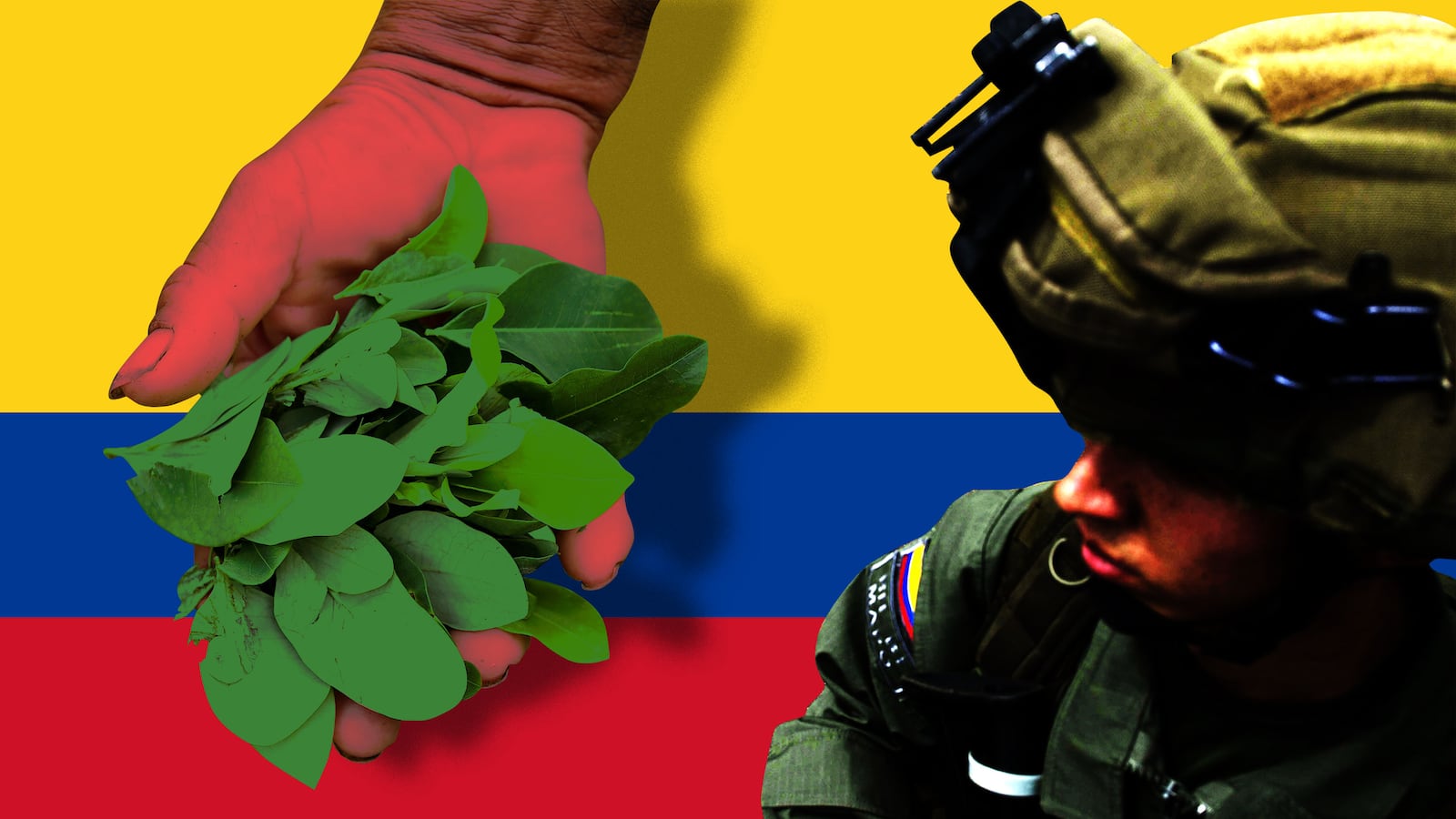In a grim display of violence, Colombian security forces opened fire on demonstrating farmers last week in southwest Nariño state.
The farmers were protesting the eradication of their coca fields when the shootings occurred.
The actual number of dead and injured remains in dispute. The Prosecutor’s Office puts the number at seven dead and 30 wounded. Rights groups representing the farmers put the tally at 16 dead and more than 50 wounded.
And the death count might be even higher. Families report several people are still missing, including a 13-year-old boy. Victims allege police are “hiding evidence,” and that additional corpses have yet to be recovered from the scene of the “massacre.”
In the wake of the shooting, critics charge government officials also attempted to cover up the circumstances so as to deny responsibility.
Three days after the shooting, police officers in the same region of Nariño again launched grenades and live rounds against unarmed civilians. This time targeting a team of journalists and human rights workers, led by a United Nations delegation, that had arrived to investigate the previous incident.
The bloodshed comes on the heels of the Trump administration pressuring Colombia to cut cocaine production levels or face steep consequences. The attack could also jeopardize the already shaky peace process between Bogotá and the Revolutionary Armed Forces of Colombia (FARC), the nation’s largest rebel group.
Loco for la Coca
Early on the morning of Thursday, Oct. 5, a large contingent of police dressed in anti-riot gear deployed near the coastal town of Tumaco. The officers were on a week-long mission to eradicate coca fields in the area.
The light green coca leaves are the primary ingredient in cocaine. The plants are also the only viable source of income for impoverished Afro-Colombian and indigenous farmers in many parts of the Andean nation, which now leads the world in cocaine production.
The riot cops were met on the outskirts of Tumaco by local farmers, including the heads of the cocaleros (coca growers) union, who had gathered to protest the destruction of their valuable crops.
“They were in peaceful social mobilization, carrying out human chains without weapons or physical aggression,” Francisco Marín, the spokesperson for the National Coordination of Cultivators of Coca, Poppies and Marijuana (COCCAM) in Nariño state told The Daily Beast.
At about 10:20 a.m. union leaders were summoned to come forward by police field commanders, allegedly to begin a dialogue to resolve the standoff.
According to Marín, that’s when the “indiscriminate fire” began “from all sides” using “long rifles, tear gas and stun grenades.” The volleys continued off and on for about the next two hours, Marín said, forcing the cocaleros to flee in terror. Only when the shooting was over could “members of the community return to help the wounded and recover the bodies of those who were killed.”
But not all the victims could be recovered.

People hold a candlelight vigil to honor farmers killed during an October 5 protest by coca growers in a rural area of Tumaco, in the southwest Colombian department of Narino, in downtown Bogota on October 9, 2017.
JOHN VIZCAINO/AFP/Getty“There are families who continue to look for their relatives who are missing,” Marín said. He described the victims as “farm workers, day laborers, coca leaf pickers. They do not have direct links with armed groups,” he said, but instead sell the leaves to “intermediaries” on an independent basis.
The following Sunday, journalists and UN human rights workers also came under fire from authorities as they attempted to reach the scene of the killings. At least one person was reported wounded in the second clash.
“[The second attack] is striking and shows tremendous incompetence,” says Vanda Felbab-Brown, a senior fellow at the Brookings Institution. “Even if you have something to hide you want to pretend to be compliant. It very much seems like they’re trying to hide something but enormously incompetent in how they’re going about it.”
Located on the Pacific coast, Nariño is a major shipping point for processed cocaine headed north to Central America and Mexico on its way to the U.S. The FARC once controlled most of the drug trade in the region, but volunteered to give up illicit activity as part of the peace process aimed at ending 50 years of civil war. With much of the FARC demobilized other rebel groups, cartels, and right-wing militias have sought to take control of local drug transit and production zones.
Felbab-Brown says the twin shootings could be blamed on “bad local leadership [or] commanders losing control.” But she also speculates on a darker scenario.
“It could be a more sinister story, such as an alliance between the police unit and the bandas criminales,” she says, and adds: “It’s a common occurrence that the bandas try to massacre and beat the cocaleros into selling to them.”
(The Colombian police did not respond to interview requests for this article.)
Blame Game
National authorities, including Colombian President Juan Manuel Santos, initially denied security forces were responsible for the attack.
The “fake news” narrative put forth by officials was widely reported in Colombian media in the immediate aftermath of the tragedy. That version blamed the attack on a dissident group of FARC rebels, who had ordered the farmers to march against the officers.
When the cocaleros refused to engage in a riot, the FARC guerrillas then launched mortar rounds and opened fire on the crowd, according to the government’s initial story.
Eyewitness testimony, cellphone videos, and social media outrage soon exposed the lie.

Human rights activists and social organizations march in protest to demand the implementation of the substitution of illicit crops in the country, in Bogota, Colombia, 06 October 2017. Banner reading 'Peace. No State Crimes.'
EPA-EFE/LEONARDO MUNOZ“The police shot from point blank range into the population,” said Ariel Ávila, director of the Bogota-based Foundation for Peace and Reconciliation, in a phone call with The Daily Beast.
“There was no fighting, no cylinder bombs, no tatucos [homemade mortars]. The first statement that excuses the military forces, [and implies] that there was combat, everything indicates that it was false,” said Ávila, who blames the government’s “lies” for worsening an already bad situation “by generating suspicion and mistrust.”
Ávila also admitted to having heard “rumors that [police] are hiding the cadavers” of additional victims, and called for further investigation by an international committee.
When the original narrative become untenable, at least 102 National Police officers were suspended over the extrajudicial killings—but no official apology has yet been issued to victims’ families and loved ones by authorities.
Colombia ‘Going Crazy’ Over Threats From Trump
A few weeks ago President Donald Trump stunned officials on two continents when he threatened to decertify Colombia as a U.S. partner in the drug war, because of an increase in cocaine production.
Colombia has long been one of Washington’s closest allies in the region, receiving millions of dollars each year in military aid and training programs. However, due to what President Trump called an “extraordinary” growth in cocaine production, he warned that the country might be black-listed, relegated to the same rogue status as hostile nations like Venezuela and Bolivia.
Promising to keep decertification as an “option,” Trump warned Colombian officials to cut back the flow of marching powder coming north, stating that he wanted to see “significant progress”—or else.
It’s true that Colombian cocaine production has risen by about 34 percent over the last two years, reaching levels that would make Pablo Escobar jealous, and about 90 percent of “blow” seized in the U.S. comes from Colombia.
Part of the increase stems from President Santos’ decision to end aerial fumigation of coca crops, due to health concerns about carcinogens in those chemicals. The FARC peace treaty also includes guaranteed protection for coca growers while the government assists communities with subsidies for legal crop substitutions before dismantling their coca fields.
Drug-war hawks in Washington have blamed these public health and economic safeguards for spiking coca and cocaine production rates—leading directly to POTUS’ recent tough talk on decertifying Colombia.
Security Analyst Ávila says the recent U.S. pressure has led “to a radicalization of anti-drug policy” in places like Nariño. “The Colombian state is going crazy trying to comply, and to show President Trump [the coca quota] will be forcibly eradicated,” he said. “The pressure is felt not only in Tumaco but among all the cocaleros.”
Ávila also called Trump’s attempt at intimidation “ridiculous,” and he had the stats to back that up.
“Last year we seized 378 tons of cocaine in Colombia, and the U.S. seized just over 40 tons along the border with Mexico. That’s 378 to 40. And then they come and tell us we lack commitment to fighting drugs? That is very hypocritical. I think they lack more commitment than we do,” Ávila said.
“Trump’s comments are very unhelpful in many ways,” said Brookings fellow Felbab-Brown. Such “naïve” rhetoric is “counterproductive for the peace process, as well as how to achieve sustainable coca reduction.”
‘Premature Eradication is Very Dangerous’
In an effort to appease Washington, Colombian officials promised to eradicate at least 50 thousand hectares of coca plants this year—more than double the goal from last year, which they failed to meet.
With only three months to go in 2017 just 30,000 hectares have been destroyed, according to Ávila, making it “difficult indeed” to meet the self-imposed target.
“Colombia is committed to meeting the eradication goal of 50,000 hectares [more than 123,000 acres] to impress the U.S.,” he said. “Therefore the clashes, the shocks, are going to continue in campesino [peasant] communities throughout the country.”
Stepped up eradication efforts of late have also put authorities at loggerheads with the newly minted FARC treaty. That was the case with the forced destruction of crops in Nariño last week, which was a clear violation of the terms of the peace deal.
“The systematic non-fulfillment of the peace agreement plus the abandonment of the state played a decisive role” in events leading up to the Tumaco shooting, said COCCAM spokesperson Marín. “We will prepare stronger mobilization [against eradication] in the coming days.”
Marín’s statement echoes Felbab-Brown’s concerns that a “heavy-handed approach” could endanger both peace with the FARC as well as long-term coca cutbacks.
“If the cocaleros are very unhappy they will not cooperate,” she said. “You end up with demonstrations to which the police retaliate and this undermines all political capital.”
Alienated communities also become “more susceptible to mobilization or collusion with criminal groups, [meaning] the illegal economy will persist and thrive. Premature eradication is very dangerous,” Felbab-Brown said.
Dangerous or not, security consultant Ávila doesn’t see a change in the government’s eradication tactics anytime soon.
“The pronouncement that Trump made sent a message to the Colombian state,” he said, “that it has to fulfill the goal at any cost.”






